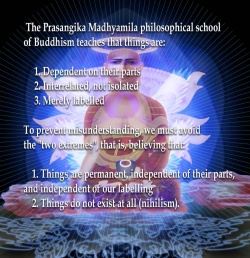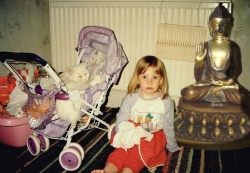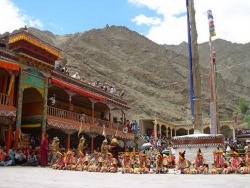Dainichi Nyorai, The Chief Deity In Shingon Buddhism
In General Buddhism, it is said that Buddhism was taught by the Buddha Sakyamuni. The Shingon Tradition however teaches that it was the dharmakaya Buddha, the Tathagata Mahavairocana, and not Íakyamuni, who taught the Shingon teachings.
Mahayana Buddhism teaches that there are three bodies (kayas) or modes of manifestation of the principal of enlightenment in the world:
1. the Dharmakaya (hosshin)
2. the Sambhogakaya (hojin)
3. the Nirmanakaya (ojin)
In other words, there are three way in which we may view the Buddha, The Enlightened One. The follower should always remember that these three are one truth, or in the words of the Shingon Tradition, "the three bodies are one (sanjin soku itsu)."
The Dharmakaya
The dharmakaya is that aspect of the Buddha which has eternal and unchanging existence. This is the foundation of being of all things in the universe. It is also the underlying foundation of being of the two other bodies of the Buddha. In the Shingon Tradition, the dharmakaya Buddha is given the name "Mahavairocana."
The Sambhogakaya
The word "sambhoga" means "reward" or " recompense." When a highly advanced Bodhisattva cultivates many religious practices, these practice -- which are likened to a seed -- bear fruit (have their reward) in his attainment of Buddhahood. This state of his Buddhahood is the body of a Buddha known as sambhogakaya. In his sambhogakaya form, the Buddha appears as very large, in his glory, surrounded by hundreds of attendant Devas and Bodhisattvas, and dwelling in his Pure Land. Two examples of sambhogakaya Buddhas are Amitabha, who lives in his Pure Land, Sukhavati, and the Buddha Aksobhya, who lives in his Pure Land Abhirati.
The Nirmanakaya
The Sanskrit word "Nirmana" means " a phantom" or " a ghost." A form that is ultimately unreal, temporary, and without absolute substance. This form that the Buddha assumes, for a while, in order to teach sentient beings. A form that he assumes in order to resemble those persons he is preaching to. This is the form of the historic Buddha, the Buddha Íakyamuni. The real form of the historic Buddha Íakyamuni, who was born in North India, who attained Enlightenment under the Bodhi Tree, and who died at the age of eighty, is actually that of the dharmakaya.
In Shingon Buddhism, many buddhas are enshrined as the Chief Deity of devotion. These different buddhas each have their own unique vows and powers to help. In other words, they lead us to salvation through the power of their vows and compassion to save all living beings. For example, Avalokitesvara Bodhisattva (Kannon Bosatsu), Bhaisjyaguru Tathagata (Yakushi Nyorai), Acala Vidyaraja (Fudo Myoo), Shoten (Ganesa), and also Kobo Daishi can all be enshrined as the main deity; and therefore Shingon temples have a variety of main deities.
To explain it this way might lead one to think that the deities in Shingon Buddhism are confusingly unsystematic, but actually this is not the case. As indicated by the Vajradhatu and the Garbhakosa Mandalas that are in Shingon temples, there is a system and an interconnectedness to the deities, and it can be said that the main objects of worship in Shingon Buddhism are these two Mandalas.
However, when we meditate on these Mandalas, we note that Mahavairocana Buddha is at the center, and that surrounding him are all the buddhas, bodhisattvas, and devas that are protective deities.
Each temple, according to its past relationships and lineage, enshrines a certain deity in the Mandala as its main deity. In all matters, Shingon Buddhism takes these Mandalas as its foundation, and the overall main deity is Mahavairocana Buddha (Dainichi Nyorai), while all of the many other buddhas are emanations of Mahavairocana Buddha (Dainichi Nyorai), which is the absolute Dharma Body, and manifest themselves in the world in order to enlighten all living beings.
Therefore, even though in Shingon Buddhism the overall main deity is Mahavairocana Buddha (Dainichi Nyorai), it is all right to have an affinity for another buddha and call it one's main deity. Although the main deity in each temple is different from each other, in Shingon Buddhism the Mandalas are the main tenets, and there is a deep significance to the fact that people can establish their own respective deity for salvation and as their main deity. However, we do need to touch briefly on the matter of Mahavairocana Buddha (Dainichi Nyorai) as the overall main deity and Kobo Daishi as the main deity in Daishi belief.
The first virtue of Mahavairocana Buddha (Dainichi Nyorai) is his universal radiance that dispels the darkness, and his ability to destroy suffering and despair. His second virtue is that his radiance has neither beginning nor end, and the light of his wisdom is like the sun, which always shines regardless of whether it is day or night. His third virtue is his ability to enlighten living beings, and the greatness of his compassion expresses the fact the he is the parent of life that continues to nourish all living beings at all times. Kobo Daishi, whom we refer to as the Daishi and enshrine as a main deity, contains all the virtues of Mahavairocana Buddha (Dainichi Nyorai) and saves all living beings as a Bodhisattva eternally alive.



